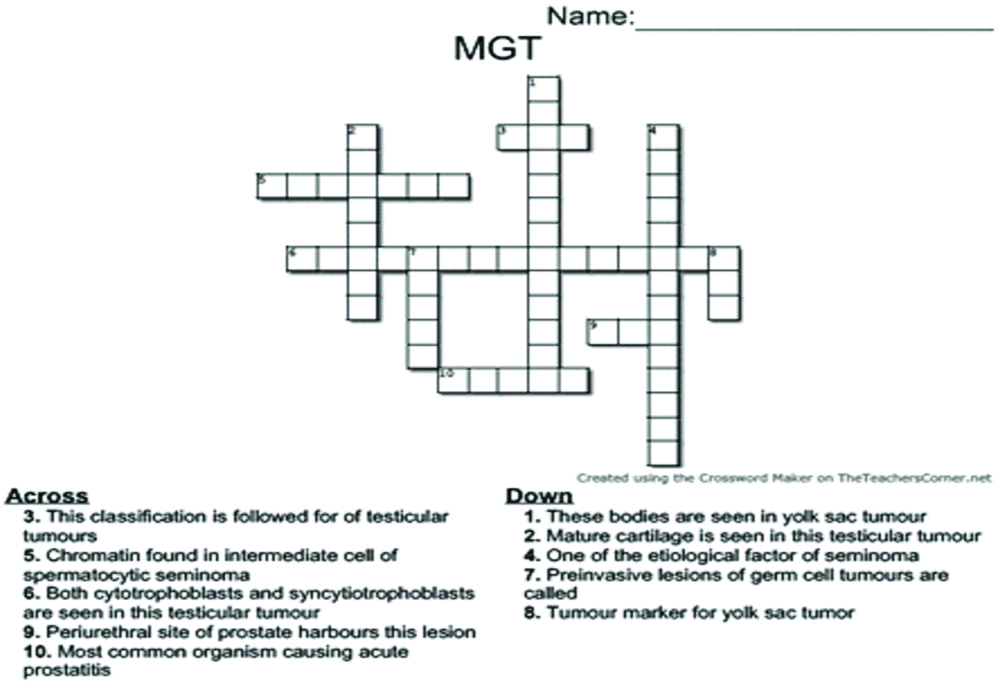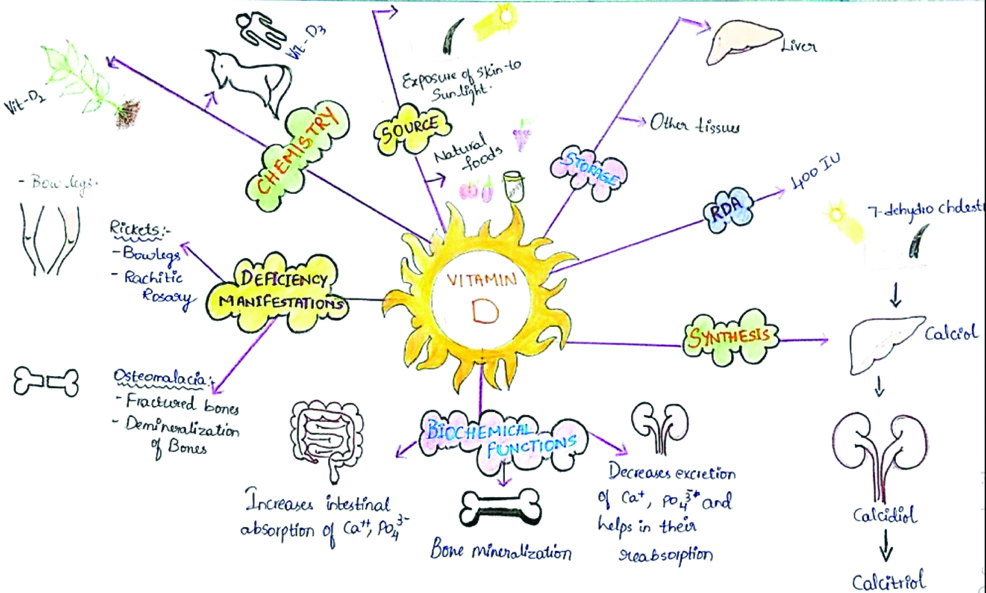Learning is a complex and multifaceted phenomenon that has excited both researchers and academics for a long time [1]. Researchers have become increasingly interested in learning and development of understanding in different disciplines, acknowledging the contextual aspects of learning [2]. Traditional health care education typically consists of classroom lectures and class discussions [3]. Research findings suggest that a deep, integrated understanding of the basic sciences, for example Anatomy, Physiology, Pathology, is important for solving clinically relevant tasks [4]. CWP is a form of active learning which is helpful to review and summarise concepts [3]. MM is a powerful graphic technique which helps in thinking clearly and improves learning of the students [5]. E-Learning provides access to many resources beyond those provided by their home institute, crossing geographic boundaries [6]. The aim of the study was to introduce newer teaching methods in the classroom and the perceptions of students regarding newer teaching methods like CWP’s, and MM’s were studied.
Materials and Methods
This was a cross sectional conducted in the Department of Pathology, NRI Medical College, Chinakakani, Guntur, Andhra Pradesh, India. Duration of study was one year from October 2018 to September 2019. Approval had been taken from Institutional Ethics Committee (under protocol number IEC NRIMC 120). The subjects were 2nd year Medical, Physiotherapy and Nursing students. A total of 206 students participated in the study of which, 90 were MBBS students, 30 were Physiotherapy students and 86 Nursing students.
Inclusion criteria: Were the students who attended all the classes and were interested and gave consent to participate in the study.
Exclusion criteria: Were absentees of the class and those who were not interested in participating. CWP’s were generated online using CWP generator (theteacherscorner.net) which is an open access platform and permission was also taken. The teaching topics covered for MBBS, Physiotherapy and Nursing students were different. All the newer teaching methods were introduced separately for MBBS, Physiotherapy and Nursing students. In a MBBS class, after delivering lecture on a specific topic, students were divided into groups of 4-6 randomly by using lottery technique. Likewise same protocol was followed in Physiotherapy and Nursing classes. A hard copy of CWP was given to each group.
For a total of 10 clues, 20 minutes were allotted. The stipulated time was derived by conducting a pilot study on students who appeared in the practical classes. After a classroom lecture, an example of MM was shown to the students and explained. They were asked to select a topic of interest and prepare their own MM manually on a white paper sheet using colour pencils to be shown by the next class. They were encouraged to use different colours and diagrams. Each student prepared a separate MM. A feedback form was given at the end to each student and their responses collected. As teaching schedules for MBBS, Physiotherapy and Nursing classes differ, the responses were collected at different timings in 4-5 months interval. The collected data was entered and analysed in MS Excel. Descriptive statistics like frequencies and percentages were used for representing the analysed data. An example of a CWP used in the present study is shown below in [Table/Fig-1].
CWP generated online on topic “Male Genital Tract”/MGT.

Results
The age of the students ranged from 18-21 years. There were 63.3% female students in MBBS, 80% in Physiotherapy and 82.6% in Nursing. Female students outweighed male students in all the branches as shown in [Table/Fig-2].
Distribution of students according to gender.
| Females | Males | Total |
|---|
| MBBS | 57 (63.3%) | 33 (36.7%) | 90 |
| Physiotherapy | 24 (80%) | 06 (20%) | 30 |
| Nursing | 71 (82.6%) | 15 (17.4%) | 86 |
Following were some of the MMs created by the students [Table/Fig-3,4 and 5].
Mind Map (MM) created by student 1.

Mind Map (MM) created by student 2.

Mind Map (MM) created by student 3.

According to [Table/Fig-6], 84.3% of MBBS students and 80% Physiotherapy students opined that routine classroom lectures were boring while only 31.4% of nursing students responded that classroom lectures were boring. 84.4% of MBBS students, 86.7% of Physiotherapy students & 97.7% of Nursing students were interested in filling CWPs. Majority of students from all branches preferred group activity rather than individual participation. A 65.6% of MBBS students, 93.3% of Physiotherapy students and 98.8% of nursing students were interested in preparing MMs. 94.4% of MBBS students, 93.3% of Physiotherapy students and 100% of nursing students opined that MMs help in memory retention.
Responses of students to questionnaire.
| S. No. | Questionnaire | MBBS (n=90) | Physiotherapy (n=30) | Nursing (n=86) |
|---|
| 1 | Lectures are boring | 76 (84.3%) | 24 (80%) | 27 (31.4%) |
| 2 | Interested in filling CWP’s | 76 (84.4%) | 26 (86.7%) | 84 (97.7%) |
| 3 | Prefer group activity | 67 (74.4%) | 21 (70%) | 63 (73.3%) |
| 4 | Interested in preparing MM’s | 59 (65.6%) | 28 (93.3%) | 85 (98.8%) |
| 5 | MM’s help in memory retention | 85 (94.4%) | 28 (93.3%) | 86 (100%) |
| 6 | Online resources for learning | 87 (96.7%) | 29 (96.7%) | 22 (25%) |
| 7 | Frequency of usage of online resources | Weekly39 (44.8%) | Weekly12 (41.4%) | Weekly10 (45.4%) |
| 8 | Most frequently used online resources | Wikipedia, Youtube | Google, Wikipedia | Google, Wikipedia |
| 9 | Newer methods create interest in subject compared to lectures | 76 (84.4%) | 27 (90%) | 72 (83.7%) |
| 10 | Wanted newer methods to be part of curriculum | 84 (93.3%) | 29 (96.7%) | 79 (91.9%) |
When asked whether they use online resources for learning, 96.7% of MBBS students, 96.7% of Physiotherapy students and 25% of nursing students responded that they use them. For approximately half of the of students from all the branches, the frequency of usage was weekly. The most commonly used online resource was Wikipedia by MBBS students, Google by Physiotherapy and Nursing students. A 84.4% of MBBS students, 90% of Physiotherapy students and 83.7% of Nursing students opined that newer methods create interest in learning subject rather than routine lectures. 93.3% of MBBS students, 96.7% of Physiotherapy students and 91.9% of nursing students wanted newer teaching methods to be part of the curriculum. The Questionnaire is given at the end of article.
Discussion
The different approaches to learning that students adopt in relation to their studies are fundamentally dependent on their intentions, i.e., whether they wish to memorise or reproduce learning material in the upcoming examination or seek meaning and develop a personal understanding of the learning Studies in Higher Education [7]. Although lectures are more of a traditional approach to teaching, evidence suggests that students today may be more engaged and learn better when there are different teaching approaches incorporated into the educational environment [8,9]. In order to be effective educators, teachers should consider incorporating a variety of different strategies of engagement that support the changing dynamics of learners [8,9]. The research by McCann A et al., also reported that students find college e-resources effective for learning. Study participants noted that e-materials would “extensively” enhance learning, such as e-lectures (59%), clinical videos (54%), and podcasts (45%) [10]. According to Gilmour J et al., the major barrier to online information to primary health care nurses was insufficient [11]. Sadoughi F et al., identified that in nursing practice, the major barrier noted was lack of time in 81% (n=17) of the reviewed studies, lack of knowledge on searching skills was identified in 66% (n=14) and lack of access to requirements in 38% (n=8) [12]. Intas G et al., found out that the obstacle for accessing e-resources were lack of time and cost in nursing students [13].
In present study, 84.4% of MBBS students were interested in filling CWP’s, which is slightly more compared to a study by Malini M et al. (74.%) [14]. 95% of MBBS students by Agarwal A and Rao SAM opined that CWP’s were helpful in identifying key concepts and they strongly agreed that they would like to participate in more of these exercises [15]. Similarly, 95% of students in a study by Saxena A et al., were interested in doing CWPs again [16]. A similarly high percentage of Nursing students in present study (97.7%) compared to Agarwal A and Rao SAM were interested in filling CWP’s [15]. A 74.4% number of MBBS students preferred group activity in present study. Similarly, in a study by Malini M et al., 70% opined that they were interested in group activity [14].
Compared to Kalyanasundaram M et al., [17] who found that 28.1% of students found MMs interesting and 40.6% opined that they helped in memory retention, a higher percentage of MBBS students in the present study were interested in preparing MMs (65.6%) and majority of them opined that they help in memory retention (94.4%). There are very few studies regarding MMs in Physiotherapy and Nursing teaching. In a study by Kaddoura M et al., 42 participants were randomly allocated to the control group which employed teaching by traditional didactic learning whereas 41 participants were allocated to the intervention group that utilised mind mapping in addition to traditional didactic learning [18]. Students in the concept mapping group performed much better than students in the control group. They proposed that deans, program directors and faculties of nursing colleges should include the mind mapping teaching concept in the existing curriculum [18]. In a study by Montpetit-Tourangeau K et al., (n=93 students), learners engaged in example-based learning with physiotherapy cases in a digital learning environment, additionally providing a concept map to complete, resulted in better performance on immediate and delayed problem solving than additionally providing a concept map to study [19]. A 84.4% of MBBS students and 83.7% of Nursing students opined that online resources create interest in subject which is higher compared to 79% of MBBS students and 80% of Nursing students by Jyothi T and Joy P [20].
A 93.3% of MBBS students wanted newer teaching methods to be part of the curriculum which is higher compared to Malini M et al., (81%) and Mohan BS et al., (89.4%) [14,21]. All the MBBS students (100%) in a study by Kumar LR et al., wanted newer teaching methods to be part of curriculum [22]. So this implies that students from different areas wanted newer teaching methods to be part of curriculum.
Limitation(s)
The study was conducted only on 2nd year MBBS, Physiotherapy and Nursing students. A large number of students from all the semesters should have been included in the study. Feedback was not taken from the faculty. No control group for comparison of the results were included.
Conclusion(s)
Educators need to constantly change their teaching methods in order to effectively hold the attention of students. An 84.4% of MBBS students, 90% of Physiotherapy students and 83.7% of nursing students opined that newer methods create more interest in a subject compared to lectures. A 94.4% of MBBS students, 93.3% of Physiotherapy students and 100% of Nursing students opined that MMs help in memory retention. There is an increasing use of online resources or social media among medical students for learning compared to Nursing students. Most of the students from all the branches wanted newer teaching methods to be part of curriculum.